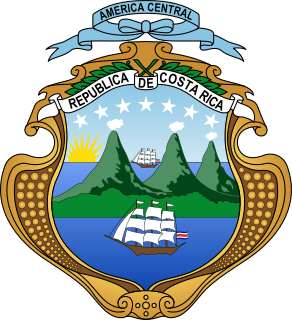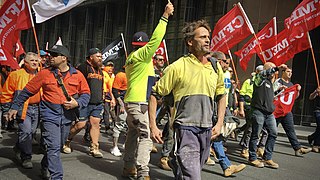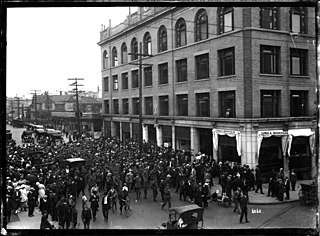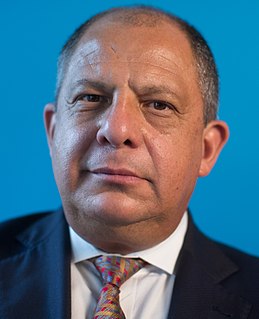
The politics of Costa Rica take place in a framework of a presidential, representative democratic republic, with a multi-party system. Executive power is exercised by the president and their cabinet, and the President of Costa Rica is both the head of state and head of government. Legislative power is vested in the Legislative Assembly. The president and 57 Legislative Assembly deputies are elected for four-year terms. The judiciary operates independent of the executive and the legislature but remains involved in the political process. Costa Rica is a republic with a strong system of constitutional checks and balances. Voting is compulsory in Costa Rica but it is not enforced.
A trade union, often simply referred to as a union, is an organization of workers who have come together to achieve common goals, such as protecting the integrity of their trade, improving safety standards, and attaining better wages, benefits, and working conditions through the increased bargaining power wielded by solidarity among workers. Trade unions typically fund the formal organization, head office, and legal team functions of the trade union through regular fees or union dues. The delegate staff of the trade union representation in the workforce are made up of workplace volunteers who are appointed by members in democratic elections.

Strike action, also called labor strike, labour strike, or simply strike, is a work stoppage, caused by the mass refusal of employees to work. A strike usually takes place in response to employee grievances. Strikes became common during the Industrial Revolution, when mass labor became important in factories and mines. In most countries, strike actions were quickly made illegal, as factory owners had far more power than workers. Most Western countries partially legalized striking in the late 19th or early 20th centuries.
Collective bargaining is a process of negotiation between employers and a group of employees aimed at agreements to regulate working salaries, working conditions, benefits, and other aspects of workers' compensation and rights for workers. The interests of the employees are commonly presented by representatives of a trade union to which the employees belong. The collective agreements reached by these negotiations usually set out wage scales, working hours, training, health and safety, overtime, grievance mechanisms, and rights to participate in workplace or company affairs.
The labor history of the United States describes the history of organized labor, US labor law, and more general history of working people, in the United States. Beginning in the 1930s, unions became important allies of the Democratic Party. Some historians question why a Labor Party did not emerge in the United States, in contrast to Western Europe.

William Julian Usery Jr. was an American labor union activist and government appointee who served as United States secretary of labor in the Ford administration.

The Citizens' Action Party is a center-left political party in Costa Rica.
Unions have been compared across countries by growth and decline patterns, by violence levels, and by kinds of political activity.

The American Postal Workers Union (APWU) is a labor union in the United States. It represents over 200,000 employees and retirees of the United States Postal Service who belong to the Clerk, Maintenance, Motor Vehicle, and Support Services divisions. It also represents approximately 2,000 private-sector mail workers.

The U.S. postal strike of 1970 was an eight-day strike by federal postal workers in March 1970. The strike began in New York City and spread to some other cities in the following two weeks. This strike against the federal government, regarded as illegal, was the largest wildcat strike in U.S. history.

Labor relations is a field of study that can have different meanings depending on the context in which it is used. In an international context, it is a subfield of labor history that studies the human relations with regard to work – in its broadest sense – and how this connects to questions of social inequality. It explicitly encompasses unregulated, historical, and non-Western forms of labor. Here, labor relations define "for or with whom one works and under what rules. These rules determine the type of work, type and amount of remuneration, working hours, degrees of physical and psychological strain, as well as the degree of freedom and autonomy associated with the work."

José La Luz is a labor activist and intellectual who organizes, promotes and advocates for worker rights in Puerto Rico and the United States. He was the architect of the grassroots campaign that resulted in the 1998 passage of Puerto Rico's Law 45, which granted bargaining rights and allowed for the unionization of over 120,000 public employees. La Luz is currently the Associate Director of the Leadership Academy for the American Federation of State, County and Municipal Employees.

Luis Guillermo Solís Rivera is a Costa Rican politician and educator who was the President of Costa Rica from 2014 to 2018. He is a member of the center-left Citizens' Action Party (PAC). Solís led the field in the 2014 presidential election, and won the presidency in a landslide election, earning more votes than any presidential candidate in the history of the nation. Solís has a long academic and political career, culminating in his election as the first President of Costa Rica to be a member of the PAC.
Ruperto Marvin Atencio Delgado is a Costa Rican lawyer, health professional, and deputy.
Henry Mora Jiménez is a Costa Rican economist and political activist. Mora is a member of the 2014-2018 Legislative Assembly of Costa Rica, serving with the Citizens' Action Party. He was the President of the Legislative Assembly of Costa Rica from 2014 to 2015.
Trade unions in Costa Rica advocate for the rights of workers in Costa Rica. Dating back to the late 1800s, labor unions in the country have been a political force. They remain active in political and social life for many Costa Ricans.
A public-sector trade union is a trade union which primarily represents the interests of employees within public sector or governmental organizations.

Carlos Andrés Alvarado Quesada is a Costa Rican politician, writer, journalist and political scientist, who is currently serving as the 48th President of Costa Rica. A member of the center-left Citizens' Action Party (PAC), Alvarado was previously Minister of Labor and Social Security during the Presidency of Luis Guillermo Solís.

Marvin Rafael de los Ángeles Rodríguez Cordero is a Costa Rican politician, teacher and labor union leader who has been the Second Vice President of Costa Rica since 8 May 2018.
This article discusses the history and present status of labor unions in Sudan.










